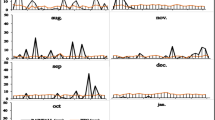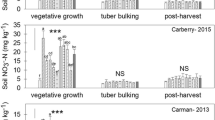Abstract
Depleting water resources in many regions of the world and increasing fertilizer nitrogen (N) cost necessitate efficient resource use. This is crucial in shallow-rooted crops like potato due to a great probability of water and N loss. In Indian Punjab, autumn potato experiences high temperature at planting time that causes poor growth and tuber yield. Mulching with crop residues provides favorable soil hydrothermal conditions that may enhance yield and economize irrigation and N use. This study examined the combined effects of residue mulch, irrigation, and N regimes on potato productivity in two soils in a subtropical environment of north-west India. Treatments included combinations of two mulch rates (0 and 6 t ha−1 rice residues) in main plots, three irrigation regimes (irrigation water to pan evaporation ratio of 2.0, 1.4, and 0.8 in the sandy loam and 2.0, 1.5, and 1.0 in the loamy sand) in subplots and four N rates (0, 135, 180, and 225 kg ha−1) in sub-subplots with three replications. Potato was planted in the second week of October with recommended doses of P2O5 and K2O and harvested in the last week of January. Tuber yield was higher in the sandy loam than in the loamy sand soil reflecting effects of available water capacity and inherent fertility. Mulching improved tuber yield by 22% on the sandy loam and by 31% on the loamy sand. Irrigation benefits were more in the sandy loam (20%) than in the loamy sand (14%). Nitrogen response was also greater in the sandy loam soil. Interactions between mulching and irrigation showed that yield gains from mulching were greater in less frequent irrigation regimes. For a given yield, mulching saved 90–100 mm of irrigation water. Mulching benefits were also greater at low N regimes, demonstrating a saving of 90 kg N ha−1 for a given yield. Mulching and N enhanced water productivity (WP), and these effects were greater in less frequent irrigations. Mulching effects on tuber yield, irrigation, and N economy are attributed to its effects on moderation of soil temperature and reduction in soil water evaporation.


Similar content being viewed by others
References
Alva AK, Ren H, Moore AD (2012) Water and nitrogen management effects on biomass accumulation and partitioning in two potato cultivars. Am J Plant Sci 3:164–170
Anonymous (2011) Agricultural statistics at a glance 2011. Directorate of Economics and Statistics, Department of Agriculture and Cooperation, Ministry of Agriculture. Government of India.www.indiastate.com
Arora VK, Singh CB, Sidhu AS, Thind SS (2011) Irrigation, tillage and mulching effects on soybean yield and water productivity in relation to soil texture. Agric Water Manag 98:563–568
Arora VK, Nath JC, Singh CB (2013) Analyzing potato response to irrigation and nitrogen regimes in a sub-tropical environment using SUBSTOR-Potato model. Agric Water Manag 124:69–76
Aulakh PS, Sur HS (1999) Effect of mulching on soil temperature soil moisture weeds population, growth and yield in pomegranate. Prog Hortic 31:131–133
Badr MA, El-Tohamy WA, Zaghloul AM (2012) Yield and water use efficiency of potato grown under different irrigation and nitrogen levels in an arid region. Agric Water Manag 110:9–15
Borah MN, Milthorpe (1963) Growth of potatoes as influenced by temperature. Indian J Plant Physiol 5:53–72
Caldiz DO, Gaspari FJ, Haverkort AJ, Struik PC (2001) Agro-ecological zoning and potential yield of single or double cropping of potato in Argentina. Agric Forest Meteorol 109:311–320
Chandra S, Singh RD, Bhatnagar VK, Bisht JK (2002) Effect of mulch and irrigation on tuber size, canopy temperature, water use and yield of potato (Solanum tuberosum L.). Indian J Agron 47:443–448
Ferreira TC, Goncalves DA (2007) Crop yield water-use production functions of potatoes grown under differential nitrogen and irrigation in a hot dry climate. Agric Water Manag 90:45–55
Gajri PR, Prihar SS, Arora VK (1993) Interdependence of nitrogen and irrigation effects on growth and input use efficiencies in wheat. Field Crops Res 31:71–86
Haverkort AJ (1990) Ecology of potato cropping systems in relation to latitude and altitude. Agric Syst 32:251–272
Ierna A, Pandino G, Lombardo S, Mauronicale G (2011) Tuber yield, water and fertilizer productivity in early potato as affected by a combination of irrigation and fertilization. Agric Water Manag 101:35–41
Igbadun HE, Ramalan AA, Oiganji E (2012) Effects of regulated deficit irrigation and mulch on yield water use and crop water productivity of onions in Samaru, Nigeria. Agric Water Manag 109:162–169
Kar G, Kumar A (2007) Effect of irrigation and straw mulch on water use and tuber yield of potato in eastern India. Agric Water Manag 94:109–116
Keeney DR, Nelson DW (1982) Nitrogen: inorganic forms. In: Page AL, Miller RH, Keeney DR (eds) Methods of soil analysis part 2. Chemical and microbiological properties. ASA-CSSA-SSSA, Madison, pp 643–698
Khera KL, Khera R, Prihar SS, Sandhu BS, Sandhu KS (1976) Mulch, nitrogen, and irrigation effects on growth, yield and nutrient uptake of forage corn. Agron J 68:937–941
Lal R (1974) Soil temperature, soil moisture and maize yield from mulched and un-mulched tropical soils. Plant Soil 40:129–143
Manrique LM (2000) Potato production in the tropics. Manrique International Agro-tech, Honolulu
Meyer RD, Marcum DB (1998) Potato yield, petiole nitrogen and soil nitrogen response to water and nitrogen. Agron J 90:420–429
Molden D, Oweis T, Steduto P, Bindraban P, Hanjra MA, Kijne J (2010) Improving agricultural water productivity: between optimism and caution. Agric Water Manag 97:528–535
Mukherjee A, Kundu M, Sarkar S (2010) Role of irrigation and mulch on yield, evapo-transpiration rate and water use pattern of tomato (Lycopersicon esculentum L.). Agric Water Manag 98:182–189
Nimah NM, Darwish LI, Bashour II (2000) Potato yield responses to deficit irrigation and N fertilization. Acta Hortic 537:823–830
Ojala JC, Stark JC, Kleinkopf GE (1990) Influenced of irrigation treatment and nitrogen management on potato yield and quality. Am Potato J 67:29–43
Patra DD, Ram M, Singh DV (1993) Influence of straw mulching on fertilizer nitrogen use efficiency, moisture conservation and herb and essential oil yield in Japanese mint (Mentha arvensis). Nutrient Cycl Agro Ecosy 34:135–139
Prihar SS, Gajri PR, Arora VK (1985) Nitrogen fertilization of wheat under limited water supplies. Fert Res 8:1–8
Sekhon NK, Singh CB, Sidhu AS, Thind SS, Hira GS, Khurana DS (2008) Effect of straw mulching, irrigation and fertilizer nitrogen levels on soil hydrothermal regimes, water use and yield of hybrid chilli. Archi Agron Soil Sci 54:163–174
Singh K (2011) Groundwater depletion in Punjab: measurement and countering strategies. Indian J Agric Econ 66:573–589
Singh B, Aujla TS, Sandhu BS, Khera KL (1988) Response of autumn potato (Solanum tuberosum L.) to irrigation and straw mulching in Northern India. Indian J Agric Sci 58:521–524
Sood MC (1986) Effect of supplemental irrigation, mulching and nitrogen levels on growth, yield and nutrient uptake of potatoes in Shimla hills. Indian J Agric Sci 56:47–55
Subbiah BV, Asija GL (1956) A rapid procedure for estimating of available nitrogen in soils. Curr Sci 25:259–260
Waddell JT, Gupta SC, Moncrief JF, Rosen CJ, Steele DD (1999) Irrigation and nitrogen management effects on potato yield, tuber quality and nitrogen uptake. Agron J 91:991–997
Author information
Authors and Affiliations
Corresponding author
Rights and permissions
About this article
Cite this article
Singh, C.B., Singh, S., Arora, V.K. et al. Residue Mulch Effects on Potato Productivity and Irrigation and Nitrogen Economy in a Subtropical Environment. Potato Res. 58, 245–260 (2015). https://doi.org/10.1007/s11540-015-9298-0
Received:
Accepted:
Published:
Issue Date:
DOI: https://doi.org/10.1007/s11540-015-9298-0




